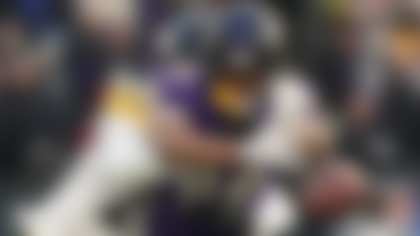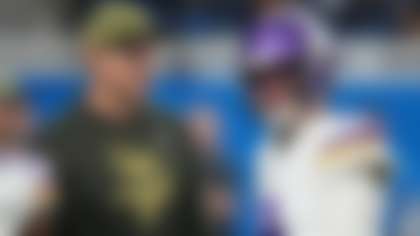The ongoing COVID-19 pandemic has created something of a moving target for the NFL during the 2020 season, but thanks to the efforts led by the league's chief medical officer Dr. Allen Sills, the league is still hitting its mark -- with a few necessary adjustments.
Sills spoke with NFL Network's Judy Battista on Thursday in an interview that aired on NFL NOW and explained the league's process in updating, tweaking and fine-tuning its COVID-19 protocols. What they've found is, as with many things in life, there are levels to mitigating the pandemic.
"We trying to prevent outbreaks," Sills said. "... But as we've gone through these 12 weeks that we've been doing this, we've learned a lot, and part of that is that not every close contact is created equal. Close contacts can actually be further classified into those that we call high risk.
"In those situations, we feel like there's a particularly high risk to the individual of contracting the virus. So in the tweak that we made to the protocol last week, we're now taking those individuals who we deem as high risk and actually isolating them from five days after the exposure as well, while we continue to test them, because we think that's the period of highest vulnerability where they themselves could test positive and then possibly expose others."
This finding has been tested once again this week with the latest COVID-19 hurdle encountered by an NFL team. This time, it's the Las Vegas Raiders, who currently have their starting offensive line in isolation as part of the league's COVID-19 protocol following right tackle Trent Brown's positive test. The NFL has already shifted the Raiders' Week 7 game against the Bucs out of the Sunday night slot, allowing for further rescheduling if things don't take a turn for the better in the hours and days ahead.
It's part of a process that includes identifying the aforementioned high-risk candidates who need immediate isolation before team and league officials start contact tracing, which includes using tracking device data, video footage from inside the team facility and practice field, and one-on-one interviews to attempt to retrace an infected player's path with the goal of identifying who might have been exposed to the novel coronavirus.
"As soon as we get a positive test, we provisionally identify potential high-risk close contacts, and we remove all those individuals right away," Sills explained. "And then there's a tremendous amount of work that goes into really fine-tuning that high-risk contact list. That includes, obviously, the KINEXON proximity tracking device data, but it also includes in-person interviews with those individuals, asking them about who they were around and the situations, and it includes video review. We take video from inside the facility and on the practice field and try to look for exposures there.
"So we take all of that information together, and then we take that preliminary list and determine a final list of high-risk contacts. So that's the same process that we've gone through in the Las Vegas situation."
The league's first significant case of internal outbreak came in Nashville, where the Tennessee Titans were forced to close their facility, postpone their Week 4 game and move up their bye week to replace it in order to mitigate the spread of COVID-19 and ensure player, coach and staff safety.
The process was somewhat prolonged by the NFL's weekly schedule standards, but it provided the league with excellent information and a few lessons that it has since employed in refining its protocols and procedures.
"We learned that it only takes a very small opening for this virus to get in and spread around a team," Sills said. "That can occur very easily away from the facility, you know, if players, coaching staff or others are getting together outside the facility, it certainly can find its way in."
A positive takeaway might have been a surprise to many: Despite infected players participating in a game before it was known they'd contracted COVID-19, the on-field transmission -- between players competing in the same game -- which many have feared did not occur.
"I think one positive takeaway that maybe folks haven't focused on quite as much is we saw no evidence of transmission between the Titans and their opponent, the Vikings, even though we know there were some players who were infected on the field," Sills said. "We've actually replicated that through a couple of other situations, so I think it's a very positive takeaway, that it seems that on-field transmission is much less likely than what might have been thought at the outset, and that sort of confirms what's being found in a lot of other sports leagues around the world.
"That's actually a positive takeaway from that situation, but clearly we've got other takeaways there that we're going to use to try to keep everyone safe when we look at these protocol changes that we've made."
As NFL Commissioner Roger Goodell recently emphasized, diligence will be paramount moving forward. The pandemic hasn't showed any signs of slowing within the United States, but the NFL aims to continue its season as scheduled. Achieving that goal will require discipline and quick response, as preventing all infections is not possible, but minimizing them is realistic when taking proper action.
"We're all going to have to double down on our efforts," Sills said. "This is getting harder. It's getting harder because everyone is more exposed outside the facility. We've seen people with babysitters and other home service providers that have created exposure, so we're just going to have to double down on our mitigations efforts both at the facility and when players, coaches and staff are away from the facility, and make sure that we quickly report any symptoms.
"We know going into cold and flu season, we will have people that have symptoms. It's just incumbent on everybody to quickly report those symptoms because in today's day and time, it's COVID until proven otherwise."












